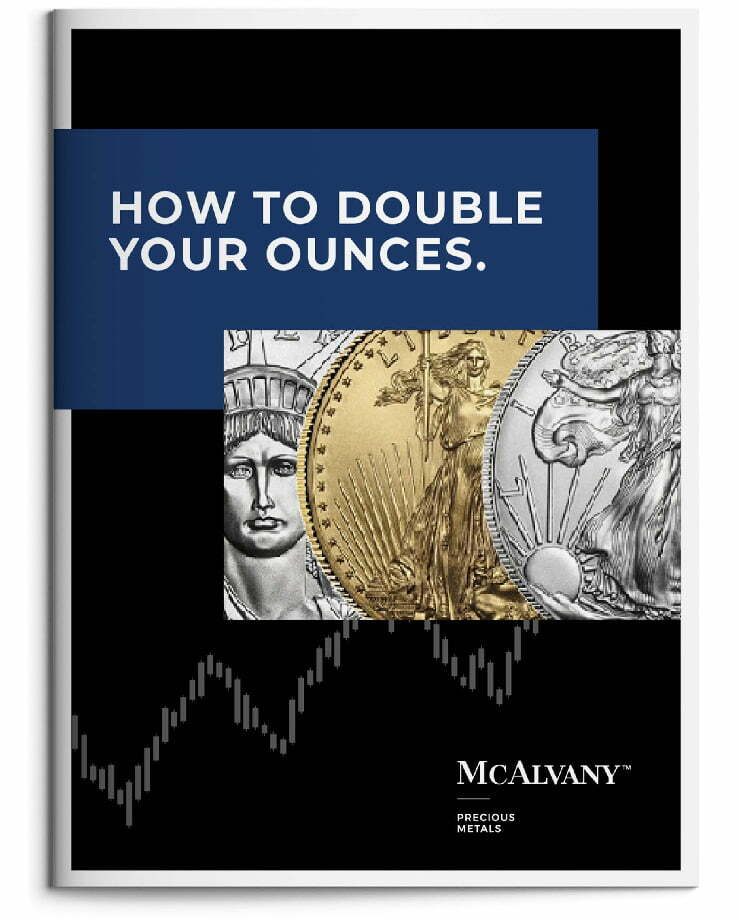Podcast: Play in new window
- Dow/Gold Ratio Is The Key
- Gold Reduces Investment Complexity
- Unemployment Shock Puts Fed In A Corner
“Your most reliable hedge is something that doesn’t do a lot of different things. It’s not like a Swiss Army knife—does a little bit of everything, but nothing very well. Gold is wealth insurance. In its purest form, it doesn’t need complexity. In fact, the performative aspects of gold— One of the things that makes it really interesting for a high-net-worth individual, a family office, an individual investor, is that it does not have complexity.” —David McAlvany
* * *
Kevin: Welcome to the McAlvany Weekly Commentary. I’m Kevin Orrick, along with David McAlvany.
David, it seems that the Fed is really caught between a rock and a hard place. Unemployment numbers came out last week. It’s not looking good. It’s looking like it could even be recessionary. Yet we have high inflation right now, so what do you do? How do you fight this without running inflation hot?
David: Yeah. There are some key figures and data points that come out this week, and a few that were given to us last week, that could be very impactful for the markets.
Kevin: So do you think this is why the rally continues right now with gold hitting all-time highs?
David: Yeah, I think it’s certainly a factor. I mean, the rally continues. We have daily new highs in gold, which come as no surprise to those that track world events and global markets. I mean, first of all, in a week’s time we had Japan and France both experience a leadership meltdown.
Kevin: Yeah, both prime ministers left.
David: In France, that’s the third government in 13 months.
Kevin: Wow.
David: Reason for no confidence? This is where, again, thinking of France and why the no confidence vote was called, the prime minister dared to suggest that deficits are unsustainable. In a socialist country, guess what happens?
Kevin: Yeah, you’re not allowed to do that.
David: No. Also, in the last week, we had the SCO Summit sponsored by Xi Jinping. It was for all intents and purposes a giant flex-off for the growing axis of anti-dollar, anti-Western strongmen.
Kevin: Do you think that was his fightback? Putin with the B-2 flyover? In a way that was embarrassing. Now, what you’re seeing is these leaders over in the East, they’re saying, “I don’t think we’ve really shown you our force.”
David: Again, think about the gold market, whether it’s a grand military parade or a humiliating no confidence vote. There are not-so-subtle signals of instability around the world, and it’s well represented on the front pages of papers. The subtler signs come in the price of things, and perhaps people are not connecting the dots between gross instability and the moves in gold.
Kevin: So why don’t we talk a little bit about the unemployment numbers, because it is pretty substantial.
David: And I think when it comes to the price of assets, most people are too busy to care, and so the things that impact the price of assets are something that are further down the food chain of interest and concern. Non-farm payrolls weak on Friday, month-over-month revisions came in less than expected, so the full report was in a mildly bad category. You got a big boost from the birth-death modeling, and there were also some seasonal adjustments which were unseasonably—or unreasonably—large relative to earlier years. Then we had revisions this week, and these are sort of full-year revisions.
Basically 911,000 jobs that we thought were in the economy are not in the economy. We must have miscounted. So the beauty of the 911,000 job revision that we got earlier this week, it makes a much stronger case for a 50 basis point cut. So it’s something that actually, bad news is good news if you’re a speculator in the stock market because you know that free money’s coming. Maybe not just the 25 basis points that are priced in, but there’s a growing probability—10%, 15, maybe even 20%—that we have a 50-basis-point cut.
Kevin: Well, let’s go to the topic of the price of things because a lot of times a person will say, “Well, what difference does it make, prices?” You remember Al, who used to work here, you could name a year and a player and he could give you a batting average for just about anybody who had played professional baseball. It was amazing.
David: Al, yeah.
Kevin: Or you could throw numbers out and he could calculate it on the fly, but you, it’s a little bit different. I can listen to you talk and it’s like, “Okay, Dave, how in the world do you keep up with all these price moves, and honestly, why?”
David: Well, the biggest reason is it’s my job, but PPI and CPI, just before we move beyond the news, big news of the week this week, we’ve got PPI and CPI, already in light of weaker employment data the probability of that 50-basis-point cut has increased. And again, I think we have to watch what happens this week with the inflation numbers. That will define the conversation and probably put some brackets around what the Fed is able to do.
Kevin: Well, inflation right now I think is pushing higher than it’s been since COVID began.
David: Yeah, it’s certainly a factor, and I think when we come back to pricing things, and coming back to assets, the subtle signs are those that come in the price of things. With the gold market, simple demand dynamics, for most people going about their routine business each day, these subtle differences really don’t factor in. I mean, yes, they care about groceries and that costing more. Very few people take notice if the yen is higher or lower by a few points. If the 10-year French government bonds tick up or down 10 basis points, it frankly takes something shocking for most people to care. My eldest son was rightly observing and maybe even criticizing my fascination with asset prices. He said something to the effect of: the frequency with which [you] look at [your] phone to see the gold price, it rivals most men’s fascination with sports statistics.
Kevin: Yeah, there’s the batting average thing, right?
David: So perhaps it would be fair to say more people would pay attention to subtle shifts in the market if they understood the game afoot and how the score is kept. Reflected in price are things like faith—faith in a group of people like the central bank—confidence, fear, ambition, boldness. And in the price of assets you have rival interests and consequential—sometimes even life and death—outcomes. What I see in the drama of prices, others find that same drama on a day-by-day basis watching football and wondering if, fourth and goal: are we going to get it across the line? For us, getting it across the line does come to the non-farm payrolls last week. It does come down to CPI and PPI. It does come down to the consequential choices that central banks are making that either create avenues of capital flowing in or shut those capital flows off.
Kevin: Yeah, so you were talking about a goal line, using that as a metaphor. There are thresholds that are very, very important on any of these price numbers.
David: And I think we’re getting to some thresholds that are garnering attention in gold. Gold is obviously breaking out to new highs for the majority across the country and around the world. There is a gasp of surprise that gold has surpassed $3,500 an ounce, now $3,650 an ounce. Only I would say a few, very few informed investors know that projections for the remainder of the year and next are migrating north of 4,000, of 5,000 an ounce amongst the Wall Street firms, and that’s happening more routinely by the day.
Kevin: So when I came in 1987, gold was between three and four hundred dollars an ounce, and to be talking about $4,000 gold, Dave, is it the end of the world? I mean, that’s what you would be thinking, possibly, from that 3, $400 level up to 4,000. Is it the end of the world? I mean, does the world think that?
David: Not if new all-time highs in the Nasdaq index are an indication. We’re not facing the end of the world. We are facing maybe the end of a valuation push to the upside. Smart money has a few considerations that are percolating up in conversations more and more, and I think those conversation points are becoming easier for all investors to appreciate.
Kevin: You just got back from, actually, a TV shoot, Dave, where you were doing a commercial, and the way you basically were presenting gold at that time was just wealth insurance. That’s a good, uncomplicated way of thinking of why gold is rising, isn’t it?
David: Yeah, the short list: Gold is tangible. It’s unlevered. It’s counterparty free. Gold functions as that asset which holds value through crisis, defaults, and political instability. So if you need a macro portfolio overlay: gold. If you need a tail risk hedge: gold. If you need a duration and diversification hedge: gold.
Kevin: So in English, wealth insurance.
David: Yeah, plain English, if you need wealth insurance: gold. It’s often criticized for lacking an income component, but the asset needs no interest rate attached to it to garner interest, and that’s one of the most intriguing aspects of gold. Gold is gold.
Kevin: But we live in a day and age— It’s funny, we have so many acronyms. I was just made fun of earlier today for not knowing the meaning of an acronym. There are just so many things thrown around. There’s a complexity to everything right now. Gold seems so simple. Do you think that that’s one of the reasons why people are moving toward it?
David: Yeah, and I think it’s one of the reasons why, up to a certain point, it’s overlooked because you’d much rather create a hedge in the derivatives market when in fact your most reliable hedge is something that doesn’t do a lot of different things. It’s not like a Swiss Army knife—does a little bit of everything, but nothing very well. Gold is wealth insurance. In its purest form it doesn’t need complexity. In fact, the performative aspects of gold— One of the things that makes it really interesting for a high-net-worth individual, a family office, an individual investor, is that it does not have complexity.
Kevin: I just had an experience with that. I have a client from Europe who came to see me and he wanted to buy gold, but he wanted to see more complexity. It was like, “Wait a second, you mean all I have to do is pay you in dollars and you will give me gold? There’s no forms to fill out. There’s no special numbers that he had to give. At first, it was a turnoff because he thought, “This can’t be true.” And then he came back and he was like, “This is too good to be true.”
David: Well, in the days of Old Bullion—that’s the famed New York Bank more formally known as Chemical Bank—deposits were secured in gold, and interest was never a consideration. You didn’t need persuasion of cash flow when the point was being in cash. In that day, it was 20s and 10s and 5s and 2.5s and $1 gold pieces. That was cash. What we were after in a cash position was the elimination of risk. So, classic story of Hetty Green selling out of her equities portfolio, making a vast fortune as an equity trader. Where did she take her money? To Old Bullion. To do what? To sit in cash, which was 20s, 10s, 5s, 2.5s, and $1 gold coins.
Kevin: Coins. Gosh, I love the simplicity of that. Now, we’ve had over 100 years of central bank management where they say you really don’t need gold.
David: Right. 112 years of central bank-run money. And maybe the real surprise is that it takes so little in interest to entice a savings allocation to something that actually has a zero intrinsic value.
Kevin: So let’s not measure gold against the dollar, because you’re right. I mean, over time the dollar is just going away. Let’s measure gold against something that actually has real value. You’ve talked so often, Dave, about the Dow/gold ratio.
David: The US economy is based in many respects on its productive capacity. We’ve, in recent years, looked at how consumers spend, and we’ve looked at services, but there was a point in time where you could predicate our growth and our trajectory on the things that we produced, the industrials, the companies that made stuff.
Kevin: The GDP. I mean, honestly, that’s really what gives us our gross domestic product.
David: Yeah, the metals are shining, and I would look beyond the nominal pricing of gold and silver for what I would say is a true strategy. Within the Dow/gold ratio, you have a complex picture of both wealth destruction and wealth preservation. There is a huge story embedded in that simple ratio.
Gold is doing its job, not because the price is higher today, but because its asset preservation qualities are on display in ways that are lost on all but one in a million people. Nominal highs for gold. Well, that’s great. But guess what, we also have nominal highs for stocks. Okay? Investors remain unconcerned in their fat equity allocations. Meanwhile, if you roll the clock back to 2024—
Kevin: Just last year.
David: As gold was readying to break out in the March of 2024 timeframe, the Dow/gold ratio finished February at 19 to 1.
Kevin: Yeah. Where is it today?
David: Today, the ratio between the Dow Industrials and one ounce of gold comes in at 12.5. Translation, in spite of fresh nominal highs in the equity markets, equities are off 34% in real money terms since the end of February 2024.
Kevin: And you’re calling gold real money, which you should.
David: No one seems to care. Very few people take notice. We live our lives in dollars and cents. We don’t live our lives in ounces. So nominal values define the conversation for most investors.
Kevin: So what you’re saying is: just for a little while, look through the world with a different lens.
David: Yeah. I beg you to see the world through a different lens. In real money terms, the Dow is not at all time highs. That feat dates back to August of 1999.
Kevin: Yeah, that was when you could get 43 ounces of gold for the Dow.
David: The Dow was exchangeable for 43 ounces of gold. Compared at present to the Dow/gold ratio of 12.5 to 1, we have witnessed a greater than 70% decline in equities.
Kevin: In real money—gold.
David: Right. By the time gold hits a 3 to 1 ratio, you’re talking about a generational loss in real money terms of 93%. That’s what we’ll have in the bag. Now, on the flip side you’ve got a generational opportunity which will present itself, transferring value from gold ounces—sometimes referred to as a pet rock, often called that—into multiples, into multiples, of exposure in equities, which is, again, the productive capacity of America.
Kevin: Yeah. So let’s talk this through. If it took 43 ounces of gold to buy the Dow back in the year 2000, and then last year it took 19 ounces of gold to buy the Dow. Now, it only takes 12.5 ounces, what you’re talking about is a compounding effect. Someday, when somebody comes out of their gold, they’re going to be able to buy multiples, like you said, 10, 20, 30—30 times.
David: That’s what we’re talking about is scaling your ownership in productive assets by 10 times, by 20 times, by 30 times, and that is no small feat. Even from today’s levels, a four-fold increase in equity exposure is what a journey from 12.5 on the ratio to 3 on the ratio holds for those that are watching how this game is played.
Embedded in the opportunity, too, is getting to keep a healthy number of ounces. This comes back to our perspective triangle. When we look at the perspective triangle, in an allocation to gold, we set as a maximum allocation for liquid assets a third. If your gold percentage has swelled because of the increase in value relative to other assets, relative to stocks in this case, when you take profits out of your gold portfolio—reduce it back to a third—you’re talking about the equivalent of having a zero cost basis portfolio in precious metals.
Kevin: So I got a call last week from a long-time client and he goes, I think it’s probably time for me to take some profits off the table. My gold has done incredibly well. I asked him, I said, “Take profits off the table and go into what?” And he goes, “Well, I’ll be going into cash.” And I said, “Well, let me ask you a question. If I were to hand you that gold right now, forget that you’ve had it, or I could hand you the equivalent value in cash. Over the next five years, which one do you choose?” And he realized that taking profits off the table and going into cash is the wrong thing. But what you’re talking about, Dave, is multiplying into the shares of productive companies in America at some point, and ultimately getting much more than dollars for your gold.
David: My bias is towards equities, because that’s the world that I exist in. There’s other investors, their world is real estate. You could look at a ratio of gold to single family homes—
Kevin: Yeah, or farmland or what have you.
David: —and see the same equivalent power in purchasing power, increase in purchasing power, multiplication of purchasing power. I mean, I’m asked the same question every day: is it time to be taking ounces off the table? And I respond that nominal prices are far less relevant than the opportunity embedded in a transfer of wealth from ounces to shares—or acres, or square feet—which is on the horizon.
One to one is the ratio low we’ve seen at dramatic inflection points over the past 100 years. Three to one is a conservative bet tied to market dynamics that require one to sell ounces into strength and buy shares on weakness. So embedded in the Dow/gold ratio and using it as a strategy is always a preference for finding value.
Kevin: So often we have people say, “Well, gosh, now that I’ve got my gold, what in the world am I ever going to do with this?” And Dave, you have always talked about having far more leverage with the exit strategy. What are you going to use the gold for next?, which is looking a little further down the road.
David: That’s what we’re geared for. From 2003—when I joined the family metals brokerage business—till now, I’ve been consistent in saying that the biggest wealth gains will not be in gold, but in what gold buys in the context of ratio contraction, in the “what’s next.”
Kevin: So if we’re talking about a ratio here, it’s division. If the Dow is 45,000 and gold is, what?, 3,500, 3,600, 3,700, we’re talking that 12 to 1 ratio. Let’s just put this in context for a second. Let’s say the Dow is 20,000 and gold goes to 10,000. Now we’re at a 2 to 1 ratio. It doesn’t take much to have that happen.
David: That’s right. I would obviously fail the trivia questions on first round draft picks, and you could surely bet against my fantasy football picks. You’ll easily win. This ratio is investment trivia which is steeped in market history. And it’s repeatable because it’s a ratio that reflects human nature.
Kevin: So when you’re talking about this exit strategy that we’re talking about, you want to figure out how much of something does the gold that you own today buy, and how much of that something will the gold tomorrow buy.
David: Right. And those numbers change in light of human nature, in light of the tendency towards greed or fear. The spectrum of greed and fear is often seen in the prices of assets. The ratio of gold to equities tells you about liquidity preferences and the degree of confidence that remains in the central bank, the managers of money. It is the clearest expression of where you are on that continuum of greed and fear.
Kevin: So what we’re really talking about is numerators and denominators and understanding what you’re actually comparing to.
David: That’s exactly right. There is a numerator, the Dow. There is the denominator, gold. Both can shift. And during market history, both do shift. The price of gold is volatile. So, also, are the prices of equities. Today, equity prices are high, and perhaps that’s going to remain the case. And that just leaves more work to be done by the denominator.
Kevin: It can work on either side.
David: That’s right. This really is fifth grade math. So today it’s $45,500 for the Dow compared to $3,650. Or perhaps the numbers move because of the numerator. What if gold goes up and we see a flatline trend in equities?
Kevin: Sure. Or vice versa. Let’s say gold just freezes here and equities come down maybe 10,000 points.
David: That’s right. Typical of this ratio— And frankly, the fast work that is typically done is when the numerator shrinks. So we’re taking $45,000 to $35,000. Keep gold at a constant, $35,000 divided by $3,650, the gold price. $25,000 for the Dow divided by $3,650. $15,000 divided by $3,650. When you get both working, that is really where time is almost at warp speed. In a bear market where nominal values are shrinking, a bear market in equities, the ratio can adjust at lightning speed. And a good part of the shift is in the numerator.
Kevin: I think one of the things that confuses people is when they see both going up, when they say, “Well, yeah, gold’s gone up, but my stocks have gone up a lot more.” The truth of the matter is when you do the division, that’s not been the case now for 25 years.
David: For 25 years. Again, we’re talking about the number being— Past tense, 1999, the Dow peaked in gold ounces at 43 to one. That’s August of 1999. From that point until now, equities have underperformed gold.
Kevin: I had a client say, “You need to tell my broker this.” So he put them on the line and the guy just couldn’t get it. No matter how I explained it. He had such a bias toward equities over the last 25 years that he could not understand that when you look at the ratio, these equities have underperformed drastically.
David: Maybe his broker just needs to revisit fifth grade math.
Kevin: We’ll learn division. I remember when my dad was upset that I had not learned division in school yet.
David: In a gold bull market, the pace of the denominator can be slow. In 25 years, we go from $350 to $3,650. That’s over a 25-year period. Now, obviously this year has picked up its pace. We’ve got 37%, 38% gains in gold, over 40% gains in silver. The pace of the numerator can join in and be quick too. And this is again where market sell-offs materialize—seemingly out of nowhere—and cover a breathtaking amount of ground. If you get a correction in equities of 20%, that can happen in a matter of weeks. It usually takes a number of quarters to see a 40% to 50% decline in equities. Often gold is, in that context, buffering those losses, moving higher at the same time as equities are moving lower. The magic of the ratio is it allows you to take an agnostic view to nominal pricing.
Kevin: Whenever we interview Neil Howe, Dave, you’ve talked to Neil multiple times on this commentary, who wrote The Fourth Turning. One of the things that’s difficult for people to do is to think in long-term cycles. And The Fourth Turning is about a secular cycle that may last 100 years. And going back, his history, the books that he’s written have gone back 500, 600, 700 years and looked at a repeating cycle. So let’s talk about the difference between short-term timing and long-term timing because really, the Dow/gold ratio, this is a secular long-term trend, not a short-term trading strategy.
David: That’s right. And we may have a correction in gold tomorrow. I don’t know. Maybe we do. That would be a cyclical trend. A long-term trend is often referred to as a secular trend. The shorter term trends are known as cyclical. The trend in the Dow/gold ratio towards one-to-one is a secular trend. It’s been in place since 1999. Many investors today are playing the game of nominal prices, and they’re making decisions based on prices they’ve never seen before. So selling gold at prices they’ve never seen before, in US dollar terms, seems really smart. But perhaps today’s price never goes a dollar higher. Let’s just take that as a base case.
Kevin: A thought experiment.
David: Perhaps gold never sees $3,750 or $4,000 or $5,000 or $8,000 an ounce. In that case, the heavy lifting for the Dow-gold Ratio comes from the numerator, it comes from a sell-off in equities. Selling gold today may be the smartest thing an investor can do if you’re pricing it in nominal terms and if there’s no case to be made for gold going a dollar higher. But on the other side of the argument is: what do you do with your denominator proceeds? The US dollar? What is the case for upside in the US dollar today?
Do you go to US Treasuries? Well, what is the case for a secular bull market in Treasuries? As we look at the complexity and the confusion in the world today, you actually see the opposite. You see a case being made against Treasuries. You see central bank reserve managers making a decision, a deliberate choice, to remove their US dollar and Treasury allocations and increase their gold positions. Why is that if in fact there is a bull case to be made for Treasuries? If you come out of gold, what if you go into US equities today? What is the bull case for equities today besides momentum? And can momentum sustain itself forever?
Kevin: When you’re talking a Buffett Ratio of, what was it, 218 the last time we looked?
David: Yeah. I mean, we’ve made the case on other podcasts that when equities reach two to three standard deviations above the mean, there is little left in terms of energy on the upside. Does that mean it’s exhausted? No, it just means that there’s little left. So on a normal bell curve, your first standard deviation accounts for 84% of the data. Two standard deviations accounts for 97.7% of the data. And three standard deviations accounts for 99.9% of the data. So when you’re valuing the US equity market today, we are in that rarefied air of two and a half to three standard deviations above the mean.
Kevin: You know what it reminds me of? When you talk about rarefied air, I fly propeller-driven airplanes. There’s an altitude limit, and there’s a point where there’s just not enough air to push that plane forward or to fly the plane. The stock market goes through these cycles, doesn’t it? It never actually goes up above certain altitudes based on these deviations.
David: Right. So said differently, we are more expensive from a valuation standpoint in the US equity market than 98.5% to 99% of all recorded market history.
Kevin: Everybody put your oxygen on right now. Put your mask on.
David: Probabilities favor numerator compression. I can’t tell you what the ultimate high price is for gold, but I can tell you that prices relative to sales, prices relative to current and projected earnings, the Cyclically Adjusted Price-Earnings ratio, the replacement value of corporations’ assets—what we refer to as the Q ratio, the market cap to GDP—what you just referred to as the Buffett Ratio. They’re telling you that your probabilities of momentum carrying the nominal value of equities even higher are pretty damn slim. This is the stuff that almost never happens. If you are hedging risk, tail risk is the stuff that 99.9% of the time is not a concern. And yet equity investors are normalizing the current nominal levels and assuming that this is sustainable.
Kevin: So this gets back to not being confused when everything’s hitting all-time highs, when the stock market’s going up, when gold’s going up. It could be, Dave— You brought up a couple of weeks ago the crack-up boom. And a crack-up boom involves everything rising at the same time. But when you look at the ratios between how they’re rising, some money’s just being completely lost.
David: Well, that’s right. Because let’s assume two different scenarios: a crack-up boom in which everything is increasing value, but not everything is increasing at the same rate.
Kevin: Like Germany back in the early 1920s.
David: That’s right. Or a deflationary bust where everything is decreasing in value, but not everything is decreasing at the same rate.
Kevin: You got to look at how they compare to each other.
David: The Dow/gold ratio gives you that insight, and the simple numerator-denominator fifth grade math tells you what’s happening and the advantages that are accruing to you. Our caveat has been that nominal prices can indeed head higher. That would be consistent with a crack-up boom. If your currency is pressed dramatically lower, all prices accelerate to the upside. A gallon of gas, loaf of bread, a cup of coffee.
Kevin: So could we be in a crack-up boom right now?
David: Yes. Are we? I don’t know. And I don’t need to know if my insights and my allocation strategies now and well into the future are tied to a ratio and not merely a nominal price. In a crack-up boom, the Dow can trade to $60,000, $80,000, $100,000, and the Dow/gold ratio can still hit three to one, two to one, one to one.
Kevin: Okay. So let’s talk about some of the uncertainties that we’re facing right now. Whether a person is pro-Trump or against Trump, we can certainly say we cannot predict the future. I mean, whether it’s geopolitical, economic, whether it has to do with tariffs because the tariffs can be on one day or taken off on another. It’s very difficult right now to be certain about anything. Do you think these uncertainties are helping gold?
David: Well, I go back to Pierre Lassonde. He was the CEO of Franco-Nevada, one of the best-run gold royalty companies on the planet. Pierre Lassonde, in a recent interview, was quoted as saying, “Mr. Trump is the gift that keeps on giving for gold.”
Kevin: And Lassonde would know.
David: And why is that? Because gold is, quite simply put—and I think it’s best understood as—wealth insurance. So if you’re talking about tariffs, if you’re talking about inflation, an unsettling and reordering of the global order, the list of elements introduced into the markets or exaggerated by the Trump administration, it’s too long to list. The recent breakout in gold after four to five months sideways consolidation relates to the threat of central bank independence being compromised.
Kevin: That was last week’s program, that the central banks are losing their independence from the political side.
David: That threat is a reality check for US dollar holders all around the world. That threat is a reality check for holders of US Treasury debt, particularly bonds. That threat is a reality check for holders of US dollar-denominated assets. That threat is one of many ways in which Trump is the gift that keeps on giving for the gold market.
Kevin: Well, and we’ve talked over the last few months that this is one of the most unusual bull markets in gold because really the public’s not participating yet. They haven’t even arrived. It’s the central bankers that are doing this.
David: Yeah. It’s not enough to know that gold has support from central bank reserve managers exiting US dollars. That preference could shift. It’s not enough to know that prices may be considerably higher in the years ahead. I think that without a strategy you’re in the dumb money category playing momentum. And I say that with all respect, but you’re in the dumb money category if you don’t have a strategy, if you don’t have a preference for an asset allocation tied to something outside of nominal prices, whether it’s momentum in stocks or momentum in crypto or momentum in meme stocks, momentum in even gold and silver. Reflected in price—as we said earlier—reflected in price are things like faith, confidence, fear, ambition, boldness, rival interest, consequential—even life-and-death—outcomes. Reflected in ratios, you’ll find the clarity of meaning in the data and the presence of mind to navigate an otherwise confusing world of inflated nominal values.
Kevin: I feel like in 2008, Dave, we got a glimpse of something that didn’t quite complete itself. You remember the global financial crisis, we were doing the Commentary at the time, and we actually did see the Dow/gold ratio get down to about six, but that wasn’t quite where it needed to go, was it?
David: The cycle’s not over. It wasn’t where it needed to go. We have re-initiated off of an interim level of about 22, 23-to-1 back, again, as we just said, towards 12 and a half. It’s 12 and a half at present. I think 10-to-1 is on the horizon, 6-to-1 is next, and as you mentioned, that’s the level that we reached during the global financial crisis. Why did we not see 3-to-1 or 2-to-1 or 1-to-1 in that period of time? I think the novelty of quantitative easing, the QE1, QE2, QE3, QE4, you had the implementation of TARP, you had the implementation of TALF, all of these interventionist measures by central banks. They brought out the big guns. There was a shock and awe within the marketplace that they would do whatever it takes.
Can you accomplish the same things in today’s environment? I’m highly suspicious of it. And a part of that is we’re at a different place in time. You go back to 2008 and 2009, and debt levels were under 10 trillion. Today, we’re 37 pressing towards $40 trillion. There’s not as much tolerance, if you will, for creative thinking from the Fed. Their monetary toolkit, I think, is more limited today than it was in the period of 2008 and 2009.
So, to me, 1-to-1 on the ratio is a growing probability indicative of the numerator and denominator both working at the same time. What does that translate to for you as an investor? I think it’s a generational opportunity to preserve value and convert that value down the line into productive assets capable of generating vast quantities of income and future growth.
Kevin: So a question a person needs to ask themselves is, when they’re picking a money manager or even a gold broker, how many of these opportunities have the people who are working there experienced? I remember 1987, the crash. Okay, stock market 2000. You were in stocks and bonds, you were a broker at the time. And then 2008 here. So many people are going to financial planners or they’re going to even gold companies where people have just been in the business four or five or maybe ten years. So experience really does count when you’re talking about a larger strategy than just buying something with momentum behind it.
David: Yeah, I think there are gold companies that offer product and price, and that’s great, wonderful. Set above those companies, we offer a path forwards, guidance and counsel, a strategy for effectively utilizing your insurance allocation in metals to buffer market downside, to stabilize portfolio volatility across all asset classes, to—maybe this is getting too philosophical—but empowering agency in the context of crisis and political/geopolitical turmoil, and to enable an effective what’s next.
Kevin: Right. But without preferring a particular— I’ll be honest with you, I prefer gold, and so it’s hard for me to be agnostic about it. But with you guys managing the various categories, like in McAlvany Wealth Management, you sort of have to be an agnostic, don’t you?
David: We maintain agnostic views to all asset classes. We’re interested, and we participate, in most asset classes as fiduciaries. Without reference points for value, it is, however, impossible to allocate effectively or know when critical transitions within the market are approaching.
Kevin: So if we were to summarize, though, as far as gold’s concerned, there’s more coming?
David: Yeah. As far as the precious metals—I include silver in that—as far as they’re concerned, as tempting as it is for some to call a top, never having seen metals at these levels before, I encourage you to stay the course. The best is yet to come, and we’re talking about that ratio compression. The most critical choices do not today pertain to your metals positions. I assume you have a metals position or are in the process of allocating to one. The most critical choices are about what is next and perhaps with whom.
* * *
You’ve been listening to the McAlvany Weekly Commentary. I’m Kevin Orrick along with David McAlvany. You can find us at McAlvany.com or you can call us at (800) 525-9556.
This has been the McAlvany Weekly Commentary. The views expressed should not be considered to be a solicitation or a recommendation for your investment portfolio. You should consult a professional financial advisor to assess your suitability for risk and investment. Join us again next week for a new edition of the McAlvany Weekly Commentary.
















